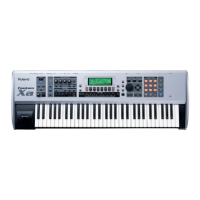Keyboard
Sound Generator Section
Maximum Polyphony
Parts
Wave Memory
Waveforms
Preset Memory
User Memory
Card Memory (PC card)
Effects
Sampling Section
Data Format
Sampling Frequency
Maximum Sampling Time
Number of Samples
Sequencer Section
Tracks
Resolution
Tempo
Note Capacity
Song Length
Recording Method
Others
Arpeggiator
Rhythm Pattern
Chord Memory
Display
Pad Buttons
Controllers
Connectors
Expansion Slots
Power Supply
Current draw
Dimensions
Weight
Accessories
61 keys (with velocity)
128 voices (shared with the sampling section)
16 parts
64 MB (16-bit linear equivalent)
1,228
Patches: 768 + 256 (GM2); Rhythm Sets: 36 + 9 (GM2); Performances: 64
Patches: 256; Rhythm Sets: 32; Performances: 64
Patches: 256; Rhythm Sets: 32; Performances: 64
Multi-Effects: 3 systems, 78 types; Chorus: 3 types; Reverb: 5 types;
Input Effects: 6 types; Mastering Effects: 3-band compressor
16-bit linear (File Type: .WAV/.AIFF)
44.1 kHz (fixed)
mono: 47 sec. approx.; stereo: 23.5 sec. approx.
*When sampling memory isn’t expanded (4 MB)
mono: 102 min. approx.; stereo: 51 min. approx.
*When sampling memory is expanded with DIMM (516 MB)
User memory: 2,000 (maximum total approximately 4 MB);
Card memory: 7,000 (PC card)
Phrase tracks (16 MIDI channels per track): 16; Tempo track: 1;
Beat track: 1; Pattern: 100
480 TPQN
5 – 300
approx. 400,000 notes
9,998 measures
Realtime recording, Step recording
Preset: 128; User: 128
Preset: 256 (32 groups); User: 256 (32 groups)
Preset: 64; User: 64
Graphic 240 x 64 dots backlit LCD
10 pads (Trigger/Category Selection/Numeric Keys)
Pitch Bend/Modulation Lever, Control Knob x 4, Assignable Switch x 2,
D Beam Controller
Headphones Jack, A (MIX) Output Jacks (L/MONO, R): 1/4-inch phone type,
B Output Jacks (L, R): 1/4-inch phone type,
Input Jacks (L/MONO/MIC, R): 1/4-inch phone type,
Hold Pedal Jack (Half Pedal recognition),
Control Pedal Jack (assignable), MIDI Connectors (IN, OUT, THRU),
USB Connector (supports file transfer and MIDI), AC Adaptor Jack
SRX expansion boards: 1 slots
DIMM: 1 slot (supports 128 MB, 256 MB, 512 MB (3.3 V))
PC Card: 1 slot (supports SmartMedia and CompactFlash using a PC card adapter)
DC 9 V (AC Adaptor)
1,200 mA
1,065 (W) x 358 (D) x 114 (H) mm, 41-15/16 (W) x 14-1/8 (D) x 4-1/2 (H) inches
10.9 kg / 24 lbs. 1 oz. (excl. AC Adaptor)
Owner’s Manual, CD-ROM (Editor, USB MIDI driver), PC Card Protector, AC Adaptor (PSB-1U)
Specifications
Fantom-X Editor Software System Requirements
■Operating System : Mac OS (Classic) 8.6 or higher, Mac OS (X) 10.2 or higher ■ CPU/Clock : PowerPC G3 / 233 MHz or higher (Classic), PowerPC G3 / 500 MHz
or higher (OS X) ■ Memory (RAM) : 128 MB or more, 256 MB or more (recommended) ■ Hard Disk : 120 MB or more ■ Display/Colors: 800 x 600 or higher /
32,000 colors or more, 1,024 x 768 or higher (recommended) ■ Other : OMS 2.0 or higher required (Classic)
Windows Macintosh
■ Operating System : Microsoft
®
Windows
®
XP, Microsoft Windows 2000 Professional, Microsoft Windows Me, Microsoft Windows 98 ■ CPU/Clock : Pentium
®
/
Celeron
®
processor 400 MHz or higher, Pentium III 500 MHz or higher (recommended) ■ Memory (RAM) : 128 MB or more, 256 MB or more (recommended)
■ Hard Disk : 120 MB or more ■ Display/Colors : 800 x 600 or higher / 65,536 colors (16 bits High Color) or more, 1,024 x 768 or higher (recommended)
Although Roland has tested numerous configurations, and has determined that on average, a computer system similar to that described above will permit normal operation of Fantom-X Editor software, Roland cannot guarantee that a given computer can be used satisfactorily with this software based solely on the fact that it meets the above
requirements. This is because there are too many other variables that may influence the processing environment, including differences in motherboard design and the particular combination of other devices involved. If you are using the system together with other software, the system requirements may exceed those listed above.

